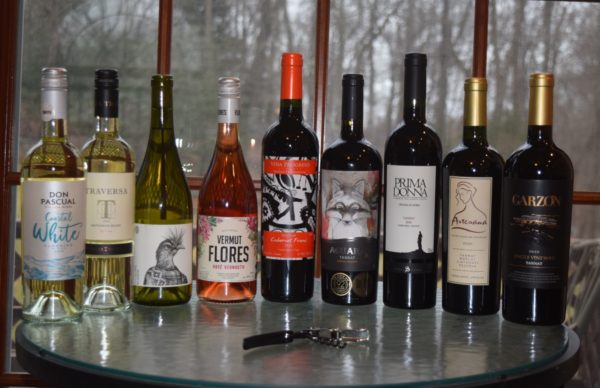Utopian Uruguay — an ascendant wine region
I was recently invited to a Uruguayan wine-tasting seminar in Manhattan where several winemakers or family representatives presented their wines and stories. Uruguay is a small country, shoe-horned between Brazil and Argentina and made up of largely Italian and Spanish immigrants. European families arrived and brought old-world winemaking experience and vines to begin creating their own wines for family and friends”™ consumption. Old world their experience may have been. However, with its wineries and vineyards, Uruguay seems to be doing everything right, using the latest techniques.
Uruguay, then, is a progressive country. With 3.4 million people, it boasts a literacy rate of 98.7% (compared with 88% in the United States). Each public-school student and teacher gets a laptop computer. The Uruguayans believe in democracy, freedom of the press and equal marriage rights and they like to party. Their carnival goes on for 50 days, eclipsing Brazil”™s, and their annual wine consumption per capita is around 24 liters, roughly double that of the United States. Meanwhile, cannabis is legal. It sounds rather Utopian.

Overlooking the Atlantic Ocean, Uruguay gets moderating winds from its proximity to the water. Most of its grapes are grown in the southern part of the country near the capital city of Montevideo. And the grapes are well-known and mostly of the noble varieties ”” Tannat, Merlot, Cabernet Sauvignon and Cabernet Franc for the reds and Sauvignon Blanc, Chardonnay, Viognier and Albarino for the whites.
Recently, a box of nine Uruguayan wines appeared at my house to accompany a Zoom presentation of the country and its wines. Many of the current winemakers there are third or fourth generation. Most of the wineries are eco-friendly and many are sustainable and organic. And as part of its modern methods, the country has employed a technique known as georeferencing in which all the planted vineyards throughout the country are numbered and coded with soil type, grape type and typical weather exposure easily found by QR code on the label. With climate change on everyone”™s mind, this could help with predicting potential damaging insect or fungal attacks, ripening and harvest times.
Tannat can be a finicky grape to tame in the bottle. I have tasted Tannats from other countries, and they can be harsh and painfully tannic. Uruguayan producers somehow know how to create a Tannat that doesn”™t need a decade or so to soften, and even just released vintages are attractive.
These are my tasting notes:
Aguará Tannat Special Reserve 2018 ”” This 100% Tannat shows dark cherry flavors with cassis and a hint of clove. It”™s a well-balanced wine to be served with anything, especially from the grill.
Artesana 2020 Reserva ”” A blend of Tannat, Merlot and Zinfandel, this wine, created by women, uses the only Zinfandel produced in all of Uruguay. It contains ripe red and dark fruit balanced with a peppery spiciness and anise. Serve it with any hearty pasta dish or just open it on a cold winter night.
Castel Pujol Folklore Blanco 2021, a Trebbiano (70%) and Malvasia blend ”” Trebbiano, also known as Ugni Blanc, is where virtually all Cognacs and Armagnacs come from. Malvasia is typically grown for fortified Madeira. Usually not respected in a wine, they become brilliant as a fermented and aged brandy or a higher alcohol-fortified wine. This wine is sustainably farmed, unfiltered and vegan and is quite attractive. It has a great mouthfeel and texture, good acidic backbone and a satisfying smoothness. Serve this Folklore Blanco with grilled shrimp, seared tuna or salmon for a lovely experience.
Don Pascual Coastal White Albariño Blend 2022 ”” Albarino, Chardonnay and Verdejo all contribute to this Spanish-style blend, featuring a crisp lemon zest, fresh and aromatic with a hint of salinity. Serve it as a welcome drink or with any fish meal.
Garzón 2020 Single Vineyard Tannat ”” A robust dark fruit red with a brilliant textured mouthfeel and tingly cinnamon accents, this wine is fresh, polished and full-bodied. Buy a few bottles and a case to put down.
Prima Donna Tannat 2018 Crianza en Roble ”” This 100% Tannat offers luscious dark fruit, pomegranate, spicy cedar notes and big aromatics. It”™s very satisfying.
Traversa Sauvignon Blanc 2022 ”” With lemon citrus notes, fine white pepper and tart green apples, this wine is crisp and puckery. Serve it with sushi, sashimi or any fish meal.
Vermut Flores (Ros̩ Vermouth) is a Tannat grape-derived Ros̩ infused with a special selection of botanicals and floral flavors to create a wonderful summer flavor. Simply add ice and orange or lemon slices, and itӪs ready to present to your company. Dominant, ripe strawberry flavors carried by the citrus will get everyone in the mood. ItӪs simple and simply delicious.
Vina Progreso Overground Cabernet Franc 2020 ”” Bright red cherry, fresh acidity, maraschino, a textured dustiness, hints of licorice and black pepper all coalesce in the glass. Serve it with any spiced pasta dish or barbecue.
Before I tasted these wines, I opened a couple of wine reference books I own to gauge their take on Uruguayan wines. “Exploring Wine: The Culinary Institute of America”™s Complete Guide to Wines of the World” and Doug Frost”™s “On Wine: A Master Sommelier and Master of Wine Tells All” were each published a couple of decades ago, but neither even had Uruguay in its index.
One more thought I”™ve mentioned before about Southern Hemisphere wines: Their grapes are harvested six months before those of the Northern Hemisphere. So the same vintage year south of the equator is six months older than in the north. For a young wine, this can be significant. All of these are attractively priced. It”™s likely you”™ll have to find a larger retail outlet to find some wines of Uruguay. But look for them. Its wines will only get better.
Write me at Doug@dougpaulding.com.